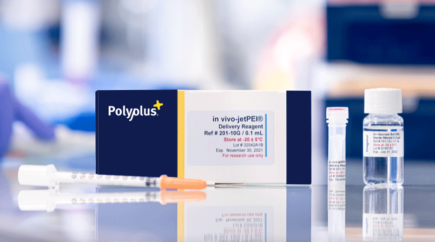in vivo-jetPEI® is a ready-to-use cationic polymer reagent recommended for in vivo transfection of DNA, siRNA, miRNA, shRNA and other oligonucleotide...

We use cookies to help you navigate efficiently and perform certain functions. You will find detailed information about all cookies under each consent category below.
The cookies that are categorized as "Necessary" are stored on your browser as they are essential for enabling the basic functionalities of the site. ...
Necessary cookies are required to enable the basic features of this site, such as providing secure log-in or adjusting your consent preferences. These cookies do not store any personally identifiable data.
Functional cookies help perform certain functionalities like sharing the content of the website on social media platforms, collecting feedback, and other third-party features.
Analytical cookies are used to understand how visitors interact with the website. These cookies help provide information on metrics such as the number of visitors, bounce rate, traffic source, etc.
Advertisement cookies are used to provide visitors with customized advertisements based on the pages you visited previously and to analyze the effectiveness of the ad campaigns.
When studying a gene function, in vivo studies are essential to validate data collected from in vitro experiments. The most commonly used animal models for in vivo studies are rodents, mostly mice (Mus musculus) and rats (Rattus norvegicus), which present several advantages such as the high similarity of their genome with human genome, but also their small size and their capacity to reproduce fast. However, depending on the functional study to be performed, many different animal models can be used, such as dog, rabbit, minipig, monkey…
One way of studying a gene function is to overexpress it by delivering into the animal a plasmid DNA encoding this gene under the control of a constitutive, tissue specific or inducible promoter. Depending on the injection route chosen, either systemic delivery of the plasmid into the whole body of the animal or local delivery to a specific organ can be obtained.
in vivo-jetPEI® from Polyplus-transfection® offers an easy and efficient method to deliver plasmid DNA into a wide range of animal models through all kinds of administration routes to obtain expression of the gene of interest into different organs.
RNA interference represents a complementary way to study the function of a gene by silencing expression of the gene of interest. This silencing can be achieved by in vivo delivery of siRNAs, miRNAs, oligonucleotides or plasmid shRNAs. Again, this can be performed either in the whole body of the animal model or it can target one specific organ, depending on the administration route chosen.
in vivo-jetPEI® is also perfectly suited to efficiently deliver either systemically or locally siRNAs, miRNAs, oligonucleotides or plasmid shRNAs to different animal models to conduct RNA interference studies in vivo. jetSI 10 mM, another reagent developed by Polyplus-transfection®, is the reagent of choice for local delivery of siRNA into the brain.